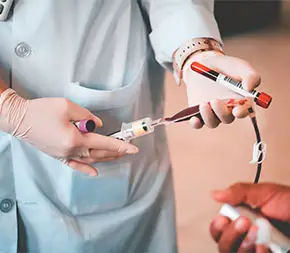Last Updated on 1 year by Francis
The field of phlebotomy is a critical part of the healthcare industry. It involves the skillful extraction of blood samples from patients, with the utmost care, in order to conduct laboratory tests. As such, the person who performs this task is an important figure in the medical world. But what do you call the person who draws blood? Well, the answer is a phlebotomist.
A person who draws blood is called a phlebotomist. Phlebotomists are healthcare professionals trained to draw blood from patients in order to collect samples for testing, donate blood, or perform other medical procedures. Phlebotomists must go through a certification process and must have a thorough understanding of anatomy and physiology. They must be skilled at using needles or other tools to draw blood from a patient’s vein.

Contents
What is a Phlebotomist?
A phlebotomist is a healthcare professional who specializes in drawing blood from a patient for medical testing, transfusions, donations, or research. They are also trained to collect and prepare specimens for lab analysis. Phlebotomists typically work in hospitals, medical laboratories, and blood donation centers.
The job of a phlebotomist involves more than just drawing blood. They must also be familiar with medical terminology, be able to assess the patient’s condition and provide quality patient care, and take important safety precautions. In order to become a phlebotomist, one must complete a phlebotomy training program and obtain certification.
What are the Responsibilities of a Phlebotomist?
A phlebotomist’s primary responsibility is to draw blood from patients in a safe and effective manner. They must also collect and prepare specimens for lab analysis, explain the procedure to patients, and ensure that the patient feels comfortable during the procedure.
In addition to drawing blood, phlebotomists must also be knowledgeable about health and safety regulations, medical terminology, infection control, and other related topics. They must also be able to accurately document the patient’s medical history and the results of the procedure.
What Skills and Attributes are Needed to be a Phlebotomist?
In order to be successful as a phlebotomist, one must have excellent communication and interpersonal skills. The ability to remain calm and professional in stressful situations is also important. Phlebotomists must also have excellent organizational skills and be able to accurately document the patient’s medical history and the results of the procedure.
In addition, phlebotomists must have a strong knowledge of health and safety regulations, medical terminology, and infection control. They must also be able to assess the patient’s condition and provide quality patient care.
What Qualifications are Needed to Become a Phlebotomist?
In order to become a phlebotomist, one must complete a phlebotomy training program and obtain certification. The training program typically consists of classroom instruction as well as practical experience. After completion of the program, one must pass a certification exam in order to become a certified phlebotomist.
In some states, additional certification may be required. It is also important for phlebotomists to stay up-to-date on current practices and procedures in order to remain certified.
What is the Job Outlook for Phlebotomists?
The job outlook for phlebotomists is very positive. The U.S. Bureau of Labor Statistics projects that the demand for phlebotomists will increase by 25% by 2026. This growth is due to an increased demand for medical testing, transfusions, and donations.
The median salary for phlebotomists is around $32,710 per year, with the highest salaries usually given to those with additional certifications.
What is the Work Environment Like for a Phlebotomist?
Phlebotomists typically work in hospitals, medical laboratories, and blood donation centers. The work environment is typically fast-paced and often involves working with other healthcare professionals.
Phlebotomists must also be comfortable working with needles and other medical equipment. They must also be able to remain calm and professional when dealing with difficult or distressed patients.
Top 6 Frequently Asked Questions
What is the Job Title of a Person Who Draws Blood?
The job title of a person who draws blood is a phlebotomist. A phlebotomist is a medical professional who specializes in collecting and processing blood samples for laboratory tests. They work with patients of all ages in a variety of settings, such as hospitals, clinics, and doctor’s offices. Phlebotomists must have excellent communication skills and the ability to remain calm and reassuring when dealing with patients who may feel anxious about the procedure. They must also take great care to ensure the accuracy and safety of each sample they collect.
What Education and Training is Required to Become a Phlebotomist?
Typically, to become a phlebotomist, you must possess at least a high school diploma or GED. Many employers may require you to have a certification from an accredited program, such as a certificate program or associate’s degree in phlebotomy. Coursework in these programs typically includes anatomy, physiology, medical terminology, infection control, and techniques for drawing and processing blood. Additionally, most programs require that students complete a supervised clinical experience in which they practice their skills in a real-world setting.
What Are the Responsibilities of a Phlebotomist?
The primary responsibilities of a phlebotomist are to collect and process blood samples for laboratory tests. This includes drawing blood from patients, labeling and storing samples, preparing specimens for testing, and entering information into medical records. Phlebotomists must also provide patients with pre- and post-procedure instructions, answer any questions they may have, and ensure they are comfortable throughout the procedure. Additionally, they may be responsible for ordering supplies, maintaining lab equipment, and adhering to safety and infection control standards.
What Skills are Necessary to be a Successful Phlebotomist?
To be a successful phlebotomist, it is important to have excellent communication skills and the ability to remain calm and reassuring when dealing with patients. It is also important to have a knowledge of anatomy and physiology, along with the proper techniques for drawing and processing blood samples. Phlebotomists must have an attention to detail and the ability to follow safety and infection control protocols. Additionally, they must be able to multitask, as they may be responsible for managing a variety of tasks at once.
What are the Benefits of Working as a Phlebotomist?
Working as a phlebotomist can offer a number of benefits, including job security and a competitive salary. Working in this field can provide you with the opportunity to work in a variety of settings, such as hospitals, clinics, and doctor’s offices. Additionally, you can gain valuable experience in the medical field, which may lead to career advancement opportunities. Finally, you can take pride in knowing that you are helping to provide critical medical care to patients.
What is the Average Salary of a Phlebotomist?
The average salary of a phlebotomist is approximately $34,000 per year, according to the Bureau of Labor Statistics. Salary can vary depending on experience, location, and other factors. Additionally, many employers may offer benefits such as health insurance, paid time off, and professional development opportunities.
To conclude, a phlebotomist is the name given to the person who draws blood. Their job is an important one and requires a great deal of skill and training, as well as a high level of professionalism. Without a phlebotomist, people would not be able to receive the medical treatments that they need, so the role is an important one.




.jpg)
.jpg)



